For homemade tomato soup you can safely can, start with ripe tomatoes, onions, garlic, broth, and optional cream, then follow a tested process: sweat aromatics, simmer with tomatoes and stock, adjust with salt and a touch of sugar, then blend to your desired texture. Use clean jars, process in a pressure canner or appropriate water-bath method, and follow strict processing times. Proper labeling and cooling are essential. Want more steps and safety tips to optimize your batches?
Ingredients and Quantity
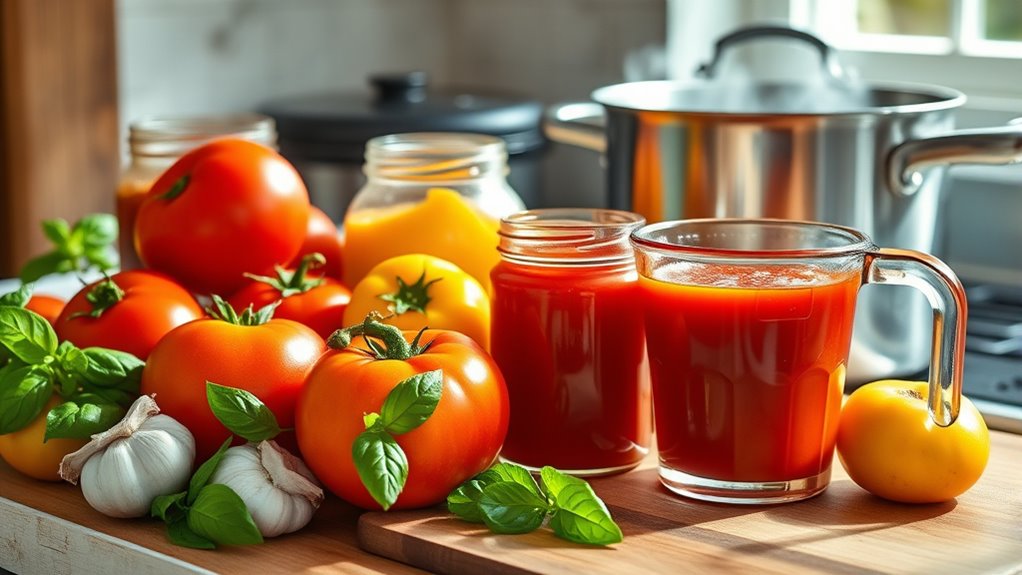
To make a homemade tomato soup, gather the following ingredients and quantities: 2 tablespoons olive oil, 1 medium onion (finely chopped), 2 cloves garlic (minced), 4 cups ripe tomatoes (chopped) or 2 cans (28 ounces) crushed tomatoes, 2 cups vegetable or chicken broth, 1 teaspoon sugar (optional, to balance acidity), 1/2 teaspoon salt (adjust to taste), 1/4 teaspoon black pepper, 1/4 cup heavy cream or 1/4 cup coconut milk (optional for richness, or dairy-free alternative), and fresh basil leaves for garnish.
| Ingredient | Quantity |
|---|---|
| Olive oil | 2 tbsp |
| Ripe tomatoes or crushed | 4 cups / 28 oz |
| Broth | 2 cups |
| Seasoning options | See notes |
Fresh tomatoes, seasoning options, you’re free to tailor for taste and texture.
Preparations
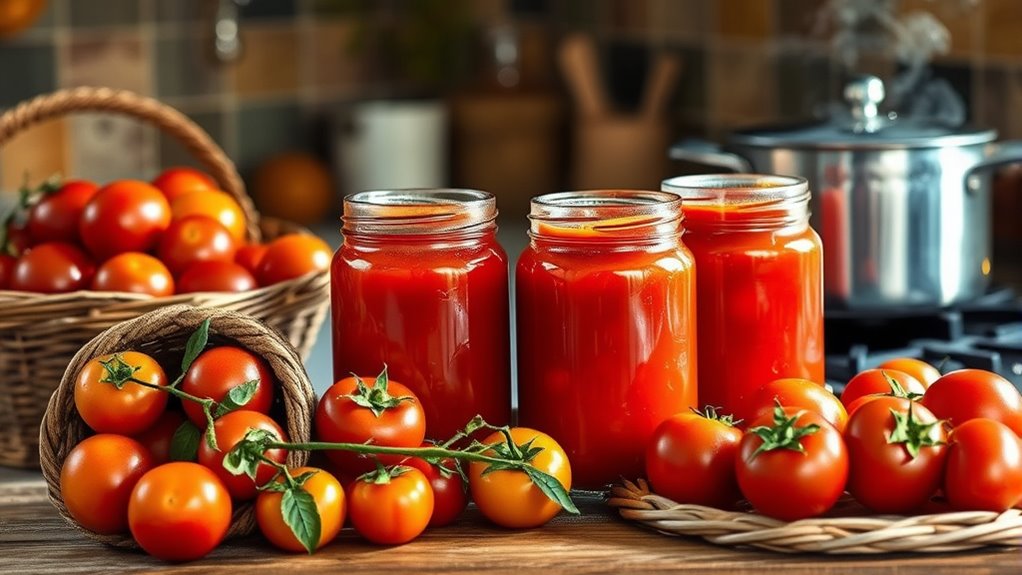
Now that you’ve gathered the ingredients, it’s time to prep them for a smooth cooking process. You’ll wash, trim, and inspect produce, discarding any imperfect pieces. Peel tomatoes if you prefer a smoother soup, but you can leave skins on for extra fibre and texture. Chop onions, garlic, and herbs evenly to guarantee uniform flavor release. For preparation techniques, consider blanching tomatoes to loosen skins, then shock in cold water to ease peeling. Measure spices and salt in advance to avoid mid-cook pauses. Practice safe handling: sanitize surfaces, keep raw and cooked foods separate, and title-swap containers as needed. When selecting ingredients, prioritize ripeness, aroma, and free-from-bracts. Ingredient selection should balance sweetness and acidity for a bright base, supporting a confident, fragrant result.
Kitchen tools or Kitchenware Required
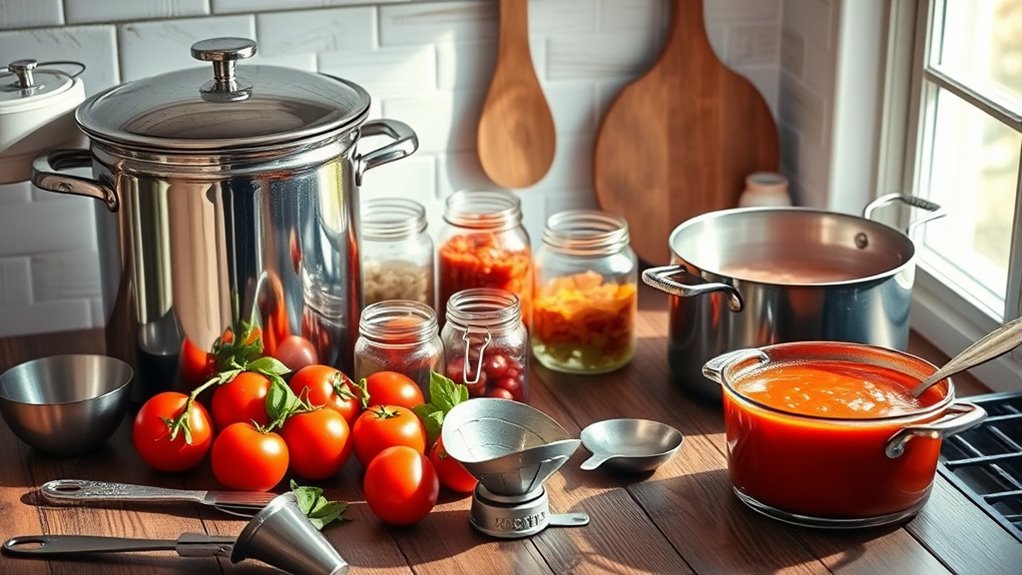
First, gather a few essential tools to keep the process smooth and safe: a sharp chef’s knife, a cutting board, a blender or immersion blender, a large pot or Dutch oven, a wooden spoon or heat-safe spatula, a ladle, and a strainer or sieve.
Kitchen tools help you stay precise and organized. The following quick table highlights core canning equipment and kitchen essentials you’ll want on hand:
| Core tools | Purpose |
|---|---|
| Canning jars & lids | Preserve safely |
| Pressure canner or water bath canner | Safe processing |
| Funnel, wand, tongs | sanitary handling |
With these items, you’ll move confidently from chopping to simmering, keeping safety front and center while you enjoy the freedom to create.
How to Cook
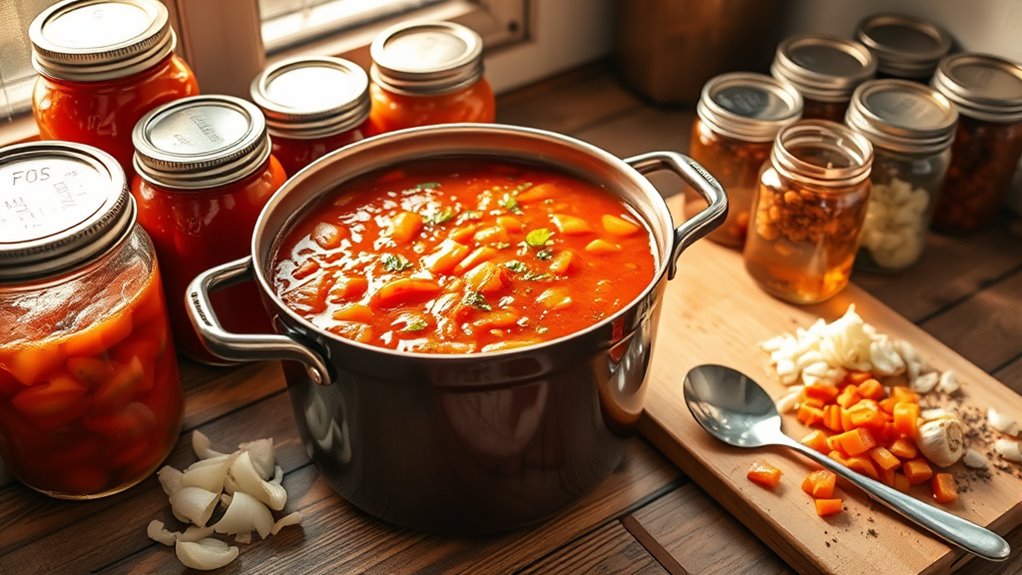
- Rinse tomatoes and wash hands thoroughly to ensure cleanliness and food safety.
- Prepare aromatics such as onions and garlic by peeling and chopping them finely.
- Heat a pot over medium heat to prepare for cooking.
- Sweat the onions and garlic in the pot until they become translucent, stirring occasionally.
- Add the tomatoes and broth to the pot.
- Bring the mixture to a gentle simmer, stirring occasionally.
- Taste the soup periodically to adjust seasoning.
- Enhance flavor by adding a pinch of sugar or a splash of balsamic vinegar, and adjust salt carefully.
- Use an immersion blender or transfer the mixture to a standard blender to achieve the desired texture.
- Return the blended soup to a gentle simmer to allow flavors to meld.
- Ensure the soup reaches a safe temperature to maintain food safety, especially if canning.
- If canning, process the soup promptly following safe canning guidelines.
- Finish by adding fresh herbs before serving.
- Serve the soup confidently, enjoying the depth of homemade flavor.
How to Serve
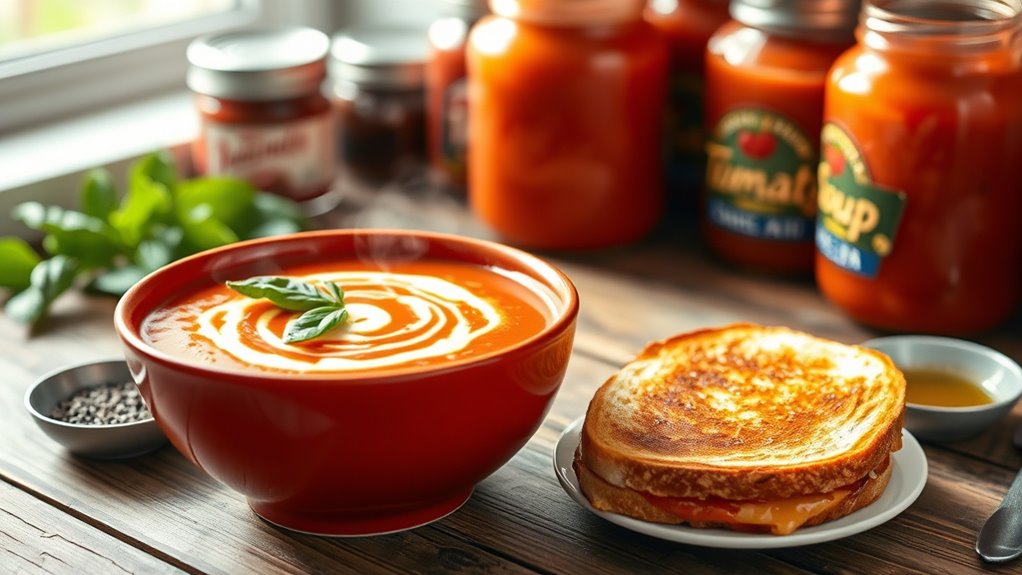
To serve homemade tomato soup, start by checking that the soup has cooled enough to handle and tastes balanced. Once confirmed, ladle into warmed bowls to maintain heat and texture. For safety, avoid splashing, use clean utensils, and never reheat in a sealed jar. Consider a light sprinkle of salt or a splash of cream if needed, but avoid over-seasoning. Garnish options should enhance rather than overwhelm the tomato base; try fresh basil, cracked pepper, or a drizzle of olive oil, allowing the soup’s brightness to shine. Serving suggestions include pairing with crusty bread, grilled cheese, or a crisp salad for balance. Keep portions consistent, label leftovers, and store promptly to preserve flavor and safety.
Tips
Tasting as you go is key: start with a small spoonful after simmering, then adjust salt, acidity, or sweetness gradually to balance the tomato base. In these tips, you’ll focus on consistent canning techniques to preserve flavor and safety. Use only ripe, crushable tomatoes and fresh aromatics to guide your decisions on ingredient selection. Wash, peel, or crush as you prefer, but maintain uniform texture for even processing. Sterilize jars properly, keep lids hot, and monitor headspace to prevent air pockets. When adjusting acidity, rely on tomatoes or a measured acidifier to stay within safe pH ranges. Label batches clearly, date all jars, and plan for shelf stability. With disciplined prep, your garden-to-pantry effort stays reliable, vibrant, and freedom-minded.
Food Value and Benefit
Tomato soup made at home is a nutritious and comforting dish that supports overall health and wellbeing. It is rich in essential vitamins and minerals that contribute to daily nutritional needs.
Food Value:
- Contains vitamins A and C, which are important for immune function and skin health.
- Provides potassium, a mineral that helps regulate blood pressure and supports muscle function.
- Packed with antioxidants, such as lycopene, which help protect cells from damage.
- Offers dietary fiber that aids digestion and promotes a feeling of fullness.
- Contains moderate amounts of sodium when prepared with low-sodium broth.
- Includes healthy fats when olive oil is added.
Health Benefits:
- Supports a strong immune system due to its vitamin and antioxidant content.
- Helps maintain healthy blood pressure and muscle function through potassium.
- Promotes digestive health and satiety thanks to fiber.
- Provides hydration and essential nutrients without excess calories.
- Offers heart-healthy fats when olive oil is included.
- Versatile and nutrient-dense when paired with whole-grain bread or additional vegetables.
Frequently Asked Questions
Can I Use a Pressure Canner for This Recipe?
Yes, you can use a pressure canner for this, but follow safety guidelines for pressure canning, not boiling-water methods. Respect time, pressure, and venting requirements, and always prioritize safety guidelines when planning your canning process.
How Long Is Canned Tomato Soup Safe to Store?
Safety first: canned soup storage lasts about 1 to 1.5 years when unopened; once opened, refrigerate 3–4 days, reheating thoroughly. Remember shelf life matters for your freedom to choose safe, nourishing meals.
Can I Freeze the Soup Instead of Canning?
Yes, you can freeze it. Use airtight containers, leave headspace, and label dates. For best texture, freeze in portions. Freezing tips: cool fully, avoid cream, and thaw safely before reheating. This impacts soup storage and safety.
Do I Need to Add Lemon Juice or Vinegar?
Yes, you should add lemon juice or vinegar to guarantee proper acidity levels for canning safety, since acidity levels affect canning safety and reduce spoilage risk while you pursue food freedom.
Can I Substitute Fresh Herbs for Dried?
Yes, you can substitute fresh herbs for dried, but expect less flavor intensity; you may need more fresh herbs to reach the same impact. Fresh vs dried matter for safety-conscious flavor balancing, especially in preserved soup. Use wisely, taste and adjust.
